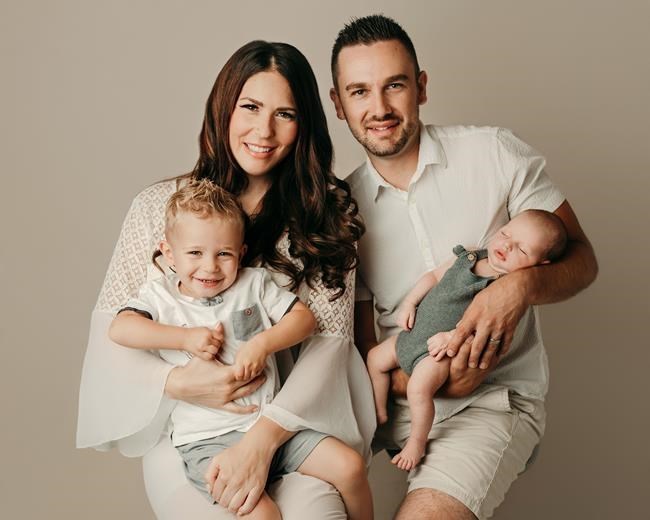Being unable to have a child naturally can be extremely difficult. But when you factor in the high costs of fertility treatments, the range of individual circumstances and the fact that the industry itself is secretive about fees, it can make the whole ordeal even more devastating and hard to plan for.
Kelsi Ribecco added up the cost of her fertility treatments since 2018 and estimates she has spent roughly$75,000. Through her husband’s work, they had unlimited coverage for medication — which is rare, she said — and they received a modest tax refund for medical expenses.
Their out-of-pocket total landed at around $50,000. They financed treatments with a line of credit, and she guessed they paid up to another $12,000 in interest.
“The reason that I like to tell people the [$75,000] total is because most people don’t have the coverage we have,” Ribecco said.
The Calgary-based marketing professional is an ambassador for Fertility Matters Canada and posts about motherhood and her fertility journey on Instagram as Ciao Kelsi.
For Ribecco, infertility was an existing condition, not due to age. She wanted kids right away, hoping to get pregnant on her honeymoon, but her case was initially deemed “male factor infertility.” Later on, “unexplained infertility” was added to their diagnosis after failed IVF attempts.
Similar to many other facets of life, inflation has also hit the fertility industry hard, Ribecco said. She recently engaged with her Instagram community about fees and heard reports of massive price increases since her own treatments. She received screen grabs of contracts; many fertility clinics in Canada do not listfees on their websites.
“When I did a frozen embryo transfer, it was about $1,800 and now it’s $2,750 at my clinic,” Ribecco said.
One in six 91ԭ��s will need fertility care, according to Fertility Matters Canada.
Ribecco’s journey, however, shows the enormous potential expense of just conceiving a child — let alone the cost of raising one. National Bank, citing Statistics Canada data, pegged the cost of raising a child to their late teens at up to $300,000.
Ribecco still considers herself lucky. She has two beautiful sons, and a great job that allowed her to attend countless appointments without being docked pay or using her vacation time.
“People with hourly rate jobs would lose wages or a whole day’s work to make appointments,” she pointed out.
LGBTQ+ couples, she added, can pay even more. Female couples need to pay for a sperm donor, and male couples need to pay for egg donation, IVF and surrogacy expenses. Egg or embryo donations can also add up if the woman has egg quality issues.
As with any foreseeable life expense, would-be parents should start a budget and savings plan as soon as they are able, said Ravy Pung, a Quebec-based financial planner with National Bank.
“It’s difficult to figure out what the total costs of [fertility treatments] will be, because it really depends on everyone’s personal situation,” she said, highlighting unexpected costs such as extra testing or failed IVF procedures, and extra expenses around surrogacy.
Pung recommended investing within a tax-free savings account, so investment returns are tax-sheltered.
There should always be a back-up plan, she added, just in case "there’s not enough liquidity, not enough savings. You should plan on how to obtain a personal line of credit or a mortgage line of credit.”
You can start planning at any time. Kalee Boisvert, a Calgary-based financial adviser with Raymond James, has clients in professional careers freezing their eggs even before they’ve found a partner.
She encourages clients in this situation to plan ahead, noting the contradiction in waiting to be financially secure before having kids — but waiting until later in life might result in a lot of costly fertility treatments.
“A lot of people end up essentially blowing through their savings,” Boisvert said.
“[Planning ahead ensures] you’re not tapping into your retirement resources. When we’re talking about having a child later in life, it kind of almost delays your targeted retirement date. You start to think, ‘Well, I don’t want to retire when they are 16, I want to keep working until they’ve gone to university.’”
The live birth rate per embryo transfer for women between 35 and 39 years old is less than 30 per cent, according to The Health Insider, citing data from the 91ԭ�� Fertility and Andrology Society.
Boisvert has heard examples of women seeking fertility treatment overseas, because some clinics will “guarantee” success at no extra cost.
“Calgary clinics don’t have that process,” she said. “If it fails, you just have to keep trying, and you have to keep paying for it each time.”
Accessibility and affordability also varies across the country.
Melissa Stasiuk, head of newsroom development for The Globe and Mail, wrote a feature for the publication in 2020 about unequal access and a “patchwork” of services, fees and government support throughout Canada.
Stasiuk and her husband spent nearly $12,000 out of pocket, after receiving funding from the Ontario Fertility Program for the procedure. She noted not everyone has government support.
“If you don’t have funding though, costs are much higher,” Stasiuk said in an email. “Like $20,000 or more higher. And sometimes people have to do more than one round.”
Many regions in Canada don’t have fertility clinics at all, Ribecco pointed out. Even if people could afford treatments, accessing a clinic there would be added time and costs for travel, flights, hotels and time off work.
“How could you even do that?” Ribecco said.
“How would it be feasible for the average 91ԭ��? It just literally wouldn’t. If you have any kind of infertility diagnosis … and you can’t afford the treatment, you just don’t get to have kids. That’s so sad.”
This report by The 91ԭ�� Press was first published May 14, 2024.
Nina Dragicevic, The 91ԭ�� Press



